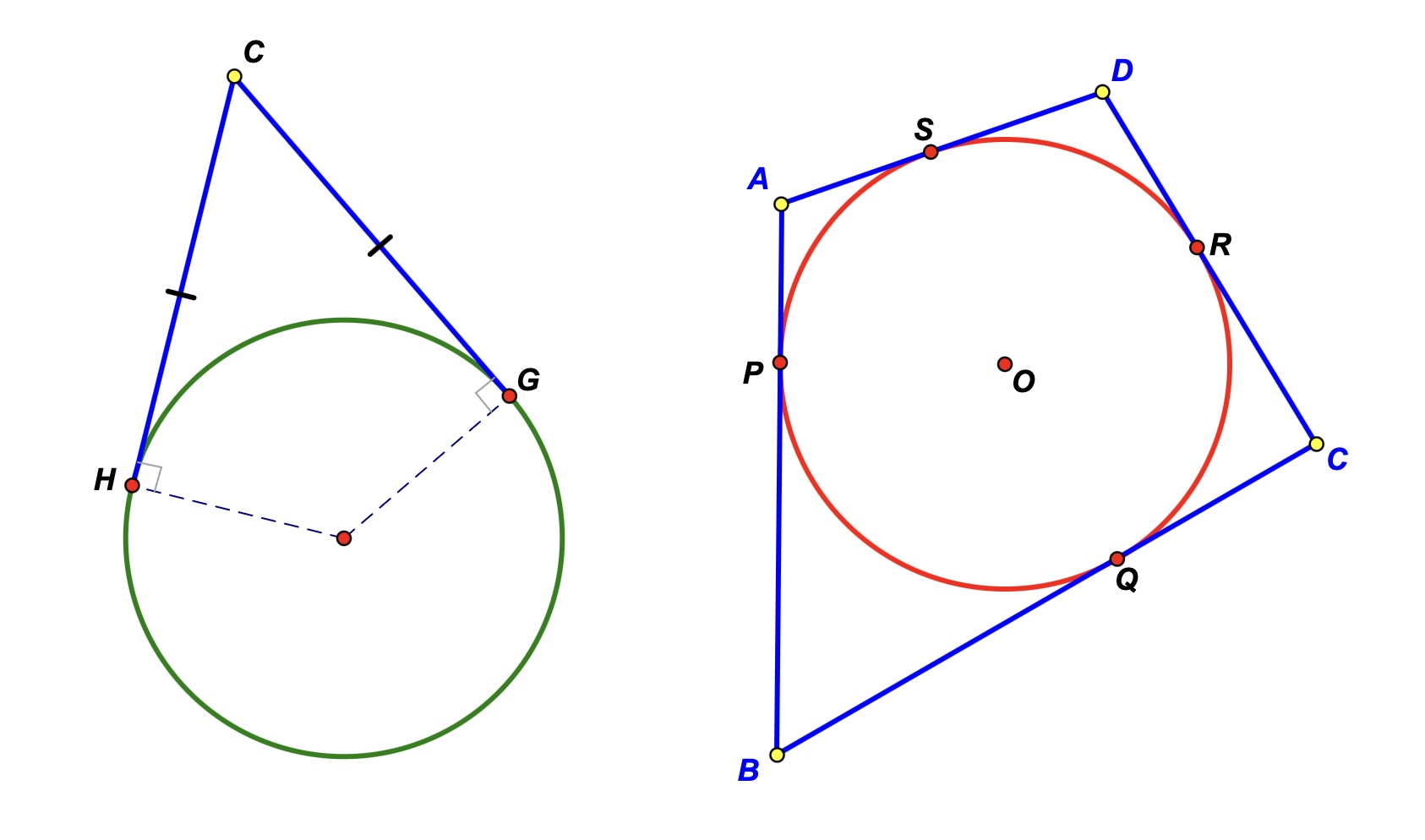
(A dynamic geometry sketch is not used in the logical derivation below)
"Logical Deduction ... is the one and only true powerhouse of mathematical thinking.." - Jean Dieudonne, in "Linear Algebra and Geometry", Hermann, Paris, 1969, p. 14.
"... the ‘discovery’ function of proof ... also more broadly refers to situations where new results are discovered in a purely logical way by the application of known theorems or algorithms without resorting to any experimentation, construction or measurement." - De Villiers (2012, p. 3)
The geometry learning activity below is from my book Rethinking Proof (free to download).
Worksheet & Teacher Notes
Open (and/or download) a guided worksheet and teacher notes to use together with the dynamic sketch below at: Logical Discovery: Circum Quad (Tangential quadrilateral) Worksheet & Teacher Notes.
Prerequisites
1) Knowledge of the familiar result that the "Tangents from an outside point to a circle are equal" - sometimes also called the "Tangent Length" theorem. See for example:
Tangent Of A Circle (Third Space Learning)
Two tangents from a point have equal length (Graphic Maths)
Theorem: Two tangents drawn from the same point outside a circle (Siyavula - after Heading 'Textbook Exercise 8.4')
2) While not essential prerequisites for the activity below, it is recommended doing the following associated activities involving circumscribed/tangential quadrilaterals either before, simultaneously, or shortly after, the activity below:
Concurrent Angle Bisectors
Theorem of Gusić & Mladinić
Logical Discovery
In the preceding Rethinking Proof Activities in the Explanatory section, you may have discovered geometric properties by first making a construction in Sketchpad and then producing a logical explanation as to why the property must hold true.
In mathematical research, however, experimentation does not always precede logical reasoning. As you may already have seen in the immediately preceding activity, Logical Discovery: Varignon Parallelogram Perimeter, and will again see in this activity, people also discover new geometric properties by logical reasoning first. Only afterward do they follow up with construction and measurement to make sure that false assumptions or conclusions have not been made.

(A dynamic geometry sketch is not used in the logical derivation below)
Discovering: Circum Quad (Tangential quadrilateral)
Without using any construction or measurement, work through the following questions using the diagrams shown below, to discover an interesting property of a circumscribed/tangential quadrilateral (a quadrilateral with sides tangent to a circle.

Recall that the two tangents from a point outside a circle to the circle are equal in length as shown above on the left.
Now use the diagram on the right above that shows a quadrilateral with all four sides tangent to a circle.
1. Consider vertex A of circum (tangential) quadrilateral ABCD. What can you say about the distances AP and AS?
2. What can you say about the distances BP and BQ, the distances CQ and CR, and the distances DR and DS?
3. Label AP as a, BP as b, CR as c, and DR as d, and write an expression for AB + CD.
4. From your observations in Questions 1 and 2, write an expression in terms of a, b, c, and d for BC + AD.
5. Compare Question 3 with Question 4. What do you notice?
6. Formulate your conclusion in Question 5 in your own words and discuss it with your partner or group.
7. From Question 6, what type of quadrilateral would ABCD be if AB = AD?

(Use the dynamic geometry sketch below to check the logical derivation above)
Check by Construction
8. Click on the 'Show Sums of Sides' button to display the measurements and sums of the sides. Check by dragging the relevant points.
Checking Logical Discovery: Circum Quad (Tangential quadrilateral)
Historical Note
This theorem about a circumscribed/tangential quadrilateral is called Pitot's theorem after a French engineer Henri Pitot (1695-1771) who proved it in 1725.
Further Exploration
9. Click on the 'Show Angle Bisectors' button to display the angle bisectors of all the angles of the circum quadrilateral. What do you notice? Can you explain your observation?
10. Which quadrilaterals (for example, parallelograms, rectangles, squares, kites, rhombuses, or squares) are special cases of a circum quadrilateral? Investigate by trying to drag your circum quadrilateral into the shapes of these special cases.
11. Is it possible to obtain a concave circum quadrilateral? If so, does your conclusion in Question 6 above still hold?
12. Click on the 'Link to Concave Circum' button to navigate to a new sketch to check your answer in Question 11.
Challenge
13. Can you adapt the original proof in Questions 3-6 to explain why (prove that) Pitot's theorem remains valid in this concave case?
Note: Using the concept or definition of 'directed distances' for our original derivation in Questions 3-6 would automatically cover the substraction of lengths CQ and CR, and still make the same proof work. Since these distances in the concave case are measured in the opposite direction than in the convex case, they can here be regarded as negative (see De Villiers, 2020a).
Converse
14. Can you formulate a converse for Pitot's theorem? Can you prove or disprove the converse?
15. Check your answer to Q14 above by clicking on the 'Link to Circum Quad Converse' button to navigate to a new sketch.
16. The new sketch shows a quadrilateral which has been constructed so that the two sums of the opposite sides are equal. Use it to investigate the general validity of the converse by dragging & clicking buttons.
Challenge
17. Can you prove that the converse is valid? Hint: Try using proof by contradiction.
18. Compare your answer to Q17 to those given in De Villiers (2020b) & Humenberger (2023) - see links below.
Historical Note: The converse of Pitot's theorem was first stated and proven by Jakob Steiner in 1846.
Further Generalization
19. Can you generalize the result further to a tangential or circumscribed hexagon?
20. Check your answer to 19) above by clicking on the 'Link to Circum Hexagon' button to navigate to a new sketch.
21. Is the converse for the circumscribed hexagon in Q20 also valid? If so, can you prove it? If not, can you provide a counter-example?
22. Can you generalize Q20 further? Compare with De Villiers (1993; 1994).
Close Nephew
A very close nephew to the circumscribed/tangential quadrilateral is the so-called Extangential Quadrilateral, which is a quadrilateral with the extensions of all four of its sides tangent to a circle exterior to the quadrilateral. In this case, it has two (distinct) sums of adjacent sides equal.
As shown in a systematic analysis in a paper by Humenberger (2023), there are four different types of extangential quadrilaterals (quads with excircles), namely, a convex, a concave and two crossed types.
Side-Angle Duality
There is a nice side-angle duality between a circumscribed/tangential quadrilateral and a cyclic quadrilateral as shown in the following comparative table:
| Circum quad | Cyclic quad |
| Angle bisectors are concurrent at the incentre of incircle. | Perpendicular bisectors of sides are concurrent at the circumcentre of circumcircle. |
| Two sums of pairs of opposite sides are equal. | Two sums of opposite angles are equal (to 180° if convex; to 720° if crossed). |
Notes
a) This is the fourth activity in Rethinking Proof which focusses on introducing students to the discovery function of logical reasoning and proof. The pedagogical intention here is to show how we can discover new results by using known or assumed results and applying deductive reasoning.
b) Follow the guided proof in the text above or use the link for the associated Worksheet at the top of this page.
c) While the 'equal tangents' result is used here as an axiom to prove Pitot's theorem, and its generalization to circumscribed 2n-gons, it can easily be proven using congruency (90°, s, s) or simply by the theorem of Pythagoras.
References & Readings
Bennett, Dan. (2012). Tangent Segments, p. 210. Exploring Geometry with Geometer's Sketchpad (free to download). Key Curriculum Press.
De Villiers, M. (1993). A unifying generalization of Turnbull's theorem. International Journal of Mathematical Education in Science and Technology, 24:2, pp. 191-196.
De Villiers, M. (1994, 1996, 2009). Generalizing Turnbull's Theorem, pp. 182-187 excerpt from Some Adventures in Euclidean Geometry (free to download). Lulu Press: Dynamic Mathematics Learning.
De Villiers, M. (1999, 2003, 2012). Rethinking Proof with Geometer's Sketchpad (free to download). Key Curriculum Press.
De Villiers, M. (2012). An illustration of the explanatory and discovery functions of proof. Pythagoras, 33(3), Art.
#193, 8 pages. DOI: https://doi.org/10.4102/pythagoras.v33i3.193.
De Villiers, M. (2020a). The Value of using Signed Quantities in Geometry. Learning and Teaching Mathematics, No. 29, pp. 30-34.
De Villiers, M. (2020b). The Tangential or Circumscribed Quadrilateral. Learning and Teaching Mathematics, No. 29, pp. 39-45.
Humenberger, H. (2023). Unusual Cyclic and Tangential Quadrilaterals – An Overview. Mathematics in School, May, pp. 26-32.
Josefsson, M. (2011). More characterizations of tangential quadrilaterals (PDF), Forum Geometricorum, 11: 65–82.
Josefsson, M. (2011). When is a Tangential Quadrilateral a Kite? (PDF), Forum Geometricorum, 11: 165–174.
Josefsson, M. (2014). Angle and Circle Characterizations of Tangential Quadrilaterals (PDF), Forum Geometricorum, 14: 1–13.
Josefsson, M. & Dalcín, M. (2021). 100 characterizations of tangential quadrilaterals (PDF), International Journal of Geometry, Vol. 10, No. 4, 32 - 62.
Minculete, N. (2009). Characterizations of a Tangential Quadrilateral (PDF), Forum Geometricorum, 9: 113–118.
Oliver, P.N. (2001). Pierre Varignon and the Parallelogram Theorem. Mathematics Teacher, Vol. 94, No. 4, April, pp. 316-319.
Oliver, P.N. (2001). Consequences of the Varignon Parallelogram Theorem. Mathematics Teacher, Vol. 94, No. 5, May, pp. 406-408.
Worrall, C. (2004). A Journey with Circumscribable Quadrilaterals (PDF), Mathematics Teacher, Vol. 98, No. 3, pp. 192-199.
Other Rethinking Proof Activities
Other Rethinking Proof Activities
Related Links
Pitot's Theorem for a tangential/circumscribed quadrilateral (Same result as above without guided proof & some diagrams)
Some Quadrilateral Inequalities involving Sides & Diagonals (See 'Some Applications' for an inequality related to circumscribed quads)
Logical Discovery: Varignon Parallelogram Perimeter (Rethinking Proof activity)
Tangential Quadrilateral Converse
Circumscribed (Tangential) Hexagon Alternate Sides Theorem
The Tangential (or Circumscribed) Polygon Side Sum theorem
Concurrent Angle Bisectors
Parallelogram Angle Bisectors (Rethinking Proof Activity)
The Equi-inclined Lines to the Angle Bisectors of a Tangential (Circumscribed) Quadrilateral
Theorem of Gusić & Mladinić
Converse of Tangent-Secant Theorem (Euclid Book III, Proposition 36)
SA Mathematics Olympiad 2016 Problem R2 Q20
A 1999 British Mathematics Olympiad Problem and its dual
Extangential Quadrilateral (Close nephew of circum quad)
Triangulated Tangential Hexagon theorem
Bicentric Quadrilateral Properties
Bicentric Quadrilateral Area Formula in terms of angles, r & R (Click on link in sketch)
Some Properties of Bicentric Isosceles Trapezia & Kites
Side Divider Theorem for a Circumscribed Quadrilateral
Conway's Circle Theorem as special case of Side Divider (Windscreen Wiper) Theorem
Japanese Circumscribed Quadrilateral Theorem
Perpendicular-Bisectors (or Circumcentres) of Circumscribed Quadrilateral Theorem
Constant perimeter triangle formed by tangents to circle
Constructing a general Bicentric Quadrilateral
Golden Kite (Generalization of golden rhombus)
Semi-regular Angle-gons and Side-gons (Generalizations of rectangles and rhombi)
Alternate sides cyclic-2n-gons and Alternate angles circum-2n-gons (Generalizations of isosceles trapezia and kites)
An Inclusive, Hierarchical Classification of Quadrilaterals
External Links
Tangential quadrilateral (Wikipedia)
Tangential Quadrilateral (Wolfram MathWorld)
A Problem in a Special Tangential Quadrilateral (Cut The Knot)
SA Mathematics Olympiad Questions and worked solutions for past South African Mathematics Olympiad papers can be found at this link.
(Note, however, that prospective users will need to register and log in to be able to view past papers and solutions.)
********************************
Back to "Dynamic Geometry Sketches"
Back to "Student Explorations"
Michael de Villiers, created with WebSketchpad, 30 Oct 2025.